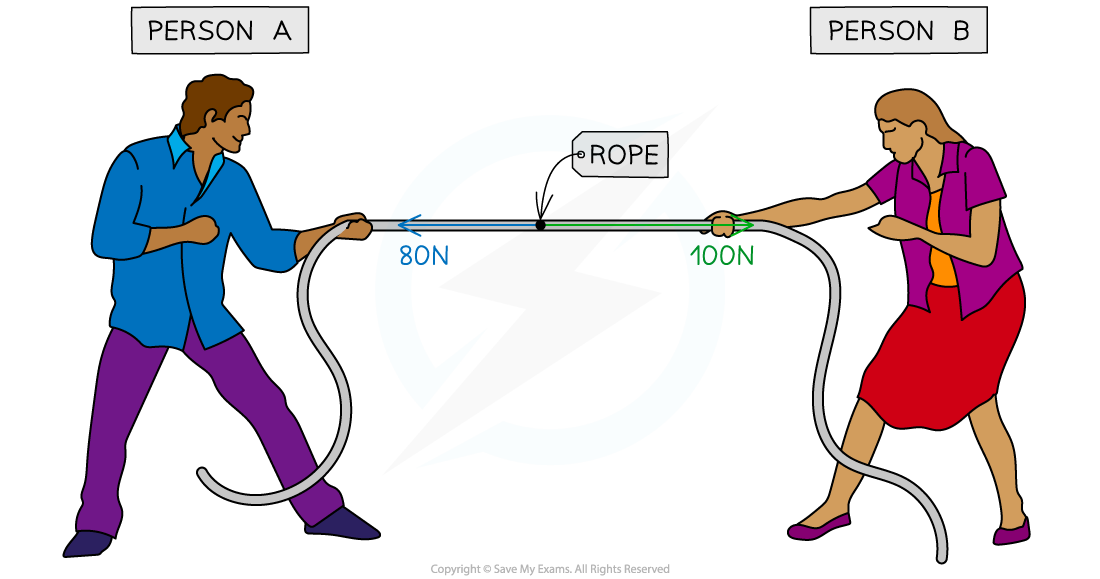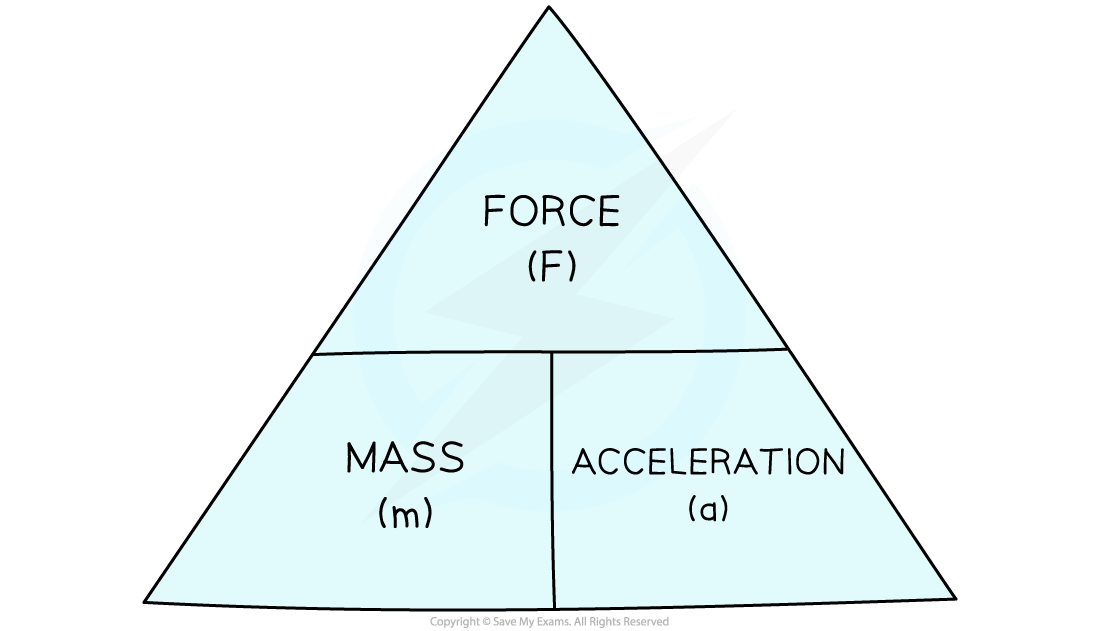Newton's Laws & Unbalanced Forces (SQA National 5 Physics): Revision Note
Exam code: X857 75
Did this video help you?
Newton's laws & unbalanced forces
Unbalanced forces
Forces acting along a straight line are said to be unbalanced if they do not cancel each other out
There is a resultant force on the object
The direction of the resultant force is in the same direction as the force with the largest size (magnitude)
Objects with unbalanced forces

When the forces are acting at right angles, the force vectors can be combined to determine the magnitude and direction of the resultant force, either by
calculation, using Pythagoras' theorem and trigonometry
Worked Example
A force acts on an object with 60 N to the right. A second force of 100 N acts on the same object in the upward direction.
Calculate the resultant force acting on the object.
Answer:
Step 1: Draw a vector diagram

Step 2: Calculate the magnitude of the resultant force using Pythagoras' theorem
Step 3: Calculate the direction of the resultant vector using trigonometry

Step 4: State the final answer, complete with magnitude and direction
Free-body diagrams
Free-body diagrams are used to show the forces acting on an object
The force vectors can be drawn onto a picture of the object, or the object can be represented by a dot
Free-body diagram of a car

The vertical forces add together
In the example of the car, the normal force and the weight are equal in magnitude and opposite in direction
Therefore, the vertical forces add up to zero
The forces are balanced in the vertical direction
The horizontal forces add together
In the car example, the thrust force has a greater magnitude than the frictional force and acts in the opposite direction
Therefore, the horizontal forces do not cancel out
There is an unbalanced force in the forward direction
Examiner Tips and Tricks
Force diagrams are any diagrams which show forces acting, whereas free-body force diagrams specifically show the forces acting on a single object. You don't need to know this terminology for your exam, but you do need to recognise if the forces shown in a diagram are acting on a single object or on multiple objects.
Newton's second law
Newton's second law of motion states:
The acceleration of an object is proportional to the unbalanced force acting on it and inversely proportional to the object's mass
Newton's second law of motion describes what happens when an unbalanced force acts on an object
An unbalanced force causes a change in the object's motion
This change in motion is an acceleration, which could involve
speeding up
slowing down
changing direction
When multiple forces act on an object, the object will accelerate in the direction of the unbalanced force
The greater the unbalanced force
, the larger the acceleration,
For a given force, the larger the object's mass
, the smaller the acceleration,
Consider two people, A and B, playing a game of tug-of-war
If person A pulls with 80 N to the left and person B pulls with 100 N to the right, there is an unbalanced force of 20 N to the right
Since person B pulled with more force than person A, the whole system (the two people and the rope) will accelerate to the right
Unbalanced forces during tug-of-war

Worked Example
Three shopping trolleys, A, B and C, are being pushed using the same force. This force causes each trolley to accelerate.

State and explain which trolley would have the smallest acceleration.
Answer: C
Step 1: Recall Newton's second law
Newton's second law states that the acceleration of an object is
proportional to the unbalanced force acting on it
inversely proportional to the object's mass
Step 2: Relate Newton's second law to the scenario
Since the same force is applied to each trolley, acceleration is inversely proportional to mass
Step 3: Explain the inverse proportionality between acceleration and mass
For the same force applied, a larger mass will experience a smaller acceleration
Therefore, trolley C will have the smallest acceleration because it has the largest mass
Calculations using Newton's second law
Newton's second law can be expressed as a relationship:
Where:
F = unbalanced force on the object, measured in newtons (N)
m = mass of the object, measured in kilograms (kg)
a = acceleration of the object, measured in metres per second squared (m s-2)
The acceleration occurs in the same direction as the unbalanced force
Relationship triangle for acceleration, mass and force

A more detailed explanation of how to use relationship triangles is covered in the revision note on motion relationships
Worked Example
A car salesman says that their best car has a mass of 910 kg and can accelerate from 0 to 27 m s-1 in 3.0 seconds.
Calculate:
a) the acceleration of the car in the first 3.0 seconds.
b) the force required to produce this acceleration.
Answer:
Part (a)
Step 1: List the known quantities
Initial velocity,
Final velocity,
Time,
Step 2: State the relationship between acceleration, time and velocity
Part (b)
Step 1: List the known quantities
Mass of the car,
Acceleration,
Step 2: Identify which law of motion to apply
The question involves quantities of force, mass and acceleration, so Newton's second law is required:
Step 3: Calculate the force required to accelerate the car
Step 4: Round to an appropriate amount of significant figures
The least precise input value is 2 s.f.
Therefore, the final answer can only be given to the same precision

Unlock more, it's free!
Did this page help you?